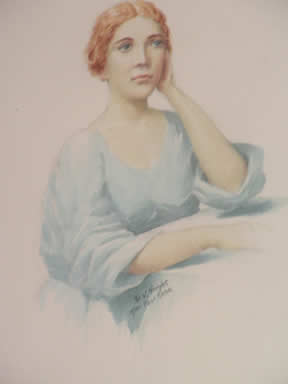Narcissa Whitman facts for kids
Quick facts for kids
Narcissa Whitman
|
|
|---|---|

Narcissa Whitman
|
|
| Born | March 14, 1808 Prattsburgh, New York, U.S.
|
| Died | November 29, 1847 (aged 39) Waiilatpu, Washington, U.S.
|
| Occupation | Missionary |
| Spouse(s) | Marcus Whitman |
Narcissa Prentiss Whitman (born March 14, 1808 – died November 29, 1847) was an American missionary. She worked in the Oregon Country, which is now the state of Washington.
In 1836, Narcissa and her husband, Marcus, traveled west. They planned to start the Protestant Whitman Mission. This mission was near what is now Walla Walla, Washington. On this journey, Narcissa and Eliza Hart Spalding became the first known European-American women to cross the Rocky Mountains.
Contents
Early Life and Dreams
Narcissa Prentiss was born in Prattsburgh, New York, on March 14, 1808. She was the third of nine children. Her parents were Judge Stephen and Clarissa Prentiss. Narcissa was the oldest of five girls. She also had four brothers.
For a while, she taught at a primary school in Prattsburgh. Like many young women then, she felt a strong religious calling. This was part of a movement called the Second Great Awakening. She decided her true goal was to become a missionary. In March 1835, she was accepted for missionary work. She studied at Franklin Academy in Prattsburgh. On February 18, 1836, she married Dr. Marcus Whitman in Angelica, New York.
Today, you can visit her birthplace in Prattsburgh. It is called the Narcissa Prentiss House. A road from Prattsburgh to Naples, New York, was once known as the Narcissa Prentiss Highway.
Journey to the West
Soon after their wedding, the Whitmans began their journey west. They traveled with Henry and Eliza Spalding, who had also just married. In March 1836, they headed for the Oregon Country. Their goal was to start missionary work among the Native Americans.
Their trip involved many ways to travel. They used sleighs, canal barges, wagons, riverboats, horses, and even walked. Narcissa kept a journal about her experiences during the trip. A man named Miles Goodyear, who later founded Ogden, Utah, traveled with them for part of the way.
On September 1, 1836, they reached Fort Walla Walla. This was a trading post run by the Hudson's Bay Company. It was near modern-day Walla Walla, Washington. They then went to Fort Vancouver. There, Dr. John McLoughlin hosted them. After that, they returned to the Walla Walla area to build their mission. Narcissa and Eliza were the first white women to cross the Rocky Mountains and live in that area. The local Cayuse found Narcissa to be a new and interesting person in their community.
Life at the Whitman Mission
The Whitman Mission started to take shape in 1837. Over time, it became a very important stop along the Oregon Trail. Many travelers heading west would stop there. For example, Methodist missionary Jason Lee visited in 1838. He was on his way east to find more people for his mission. In 1840, a mountain man named Joseph Meek also stopped by. The Whitmans had met him on their journey west.
The mission was built at a place called Waiilatpu. This spot was about six miles (10 km) from Fort Walla Walla. It was also located along the Walla Walla River. At the mission, Narcissa taught the native people from the Bible. She also taught them Western household skills. These skills, like cooking and cleaning, were new to the Native Americans.
Besides her missionary work, Narcissa managed the household. Her daily tasks included cooking meals, washing and ironing clothes, making butter, and baking. She also made candles and soap. In her letters home, she often wrote about feeling lonely and about her life at the mission.
On March 14, 1837, Narcissa turned 29. On that day, she gave birth to her only child, a daughter. This baby was the first white American born in the Oregon Country. Narcissa named her Alice Clarissa, after her grandmothers. Sadly, Alice Clarissa drowned in the Walla Walla River on June 23, 1839, when she was just two years old. She had gone to the river to get water and fell in. Her body was found quickly, but they could not save her.
However, other children came to the mission. These included the Sager orphans. Narcissa became like a second mother to them.
In late 1842, before winter, Marcus traveled back east. He went to find more missionaries for their work. While he was away, Narcissa visited other places in the territory. She went to Fort Vancouver and Jason Lee's Methodist Mission near Salem, Oregon. She also visited another mission near Astoria, Oregon. Marcus returned in 1843, bringing his nephew, Perrin, with him.
The Whitman Massacre
During their time in the Oregon Country, the Whitmans sometimes faced problems with the native tribes. The Cayuse and the Nez Percé tribe were unsure about the Americans' activities. They also worried about the settlers moving onto their land. As early as 1841, a Cayuse leader named Tiloukaikt tried to make the Whitmans leave Waiilatpu. This was the ancestral home of the Cayuse.
In 1847, a measles sickness spread among the native people. They did not have natural protection against this disease, so it spread very quickly. Many native people became very sick and died. The American settlers had some protection from measles. This meant fewer of them died. This difference made the native people upset. They felt that Marcus was only helping the white people get better, while letting their children die.
This anger grew until November 29, 1847. On that day, Tiloukaikt and other Cayuse attacked the mission. Both Narcissa and Marcus Whitman were killed. This event is known as the Whitman massacre. Eleven other people were also killed, including the young brothers John and Francis Sager. Many more people were taken as hostages. Later, five Cayuse men were held responsible for the murders.
Images for kids


